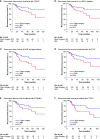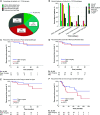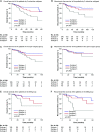Tumor Molecular Features Predict Endometrial Cancer Patients' Survival After Open or Minimally Invasive Surgeries
- PMID: 33718224
- PMCID: PMC7952993
- DOI: 10.3389/fonc.2021.634857
Tumor Molecular Features Predict Endometrial Cancer Patients' Survival After Open or Minimally Invasive Surgeries
Abstract
Background: The Cancer Genome Atlas (TCGA) project shed light on the vital role of tumor molecular features in predicting endometrial cancer patients' prognosis. This study aims to investigate the survival impact of surgical approaches on patients with different genetic alterations.
Methods: 473 endometrial cancer patients from TCGA database were selected. To analyze the prognostic impact of surgical approach, survival analyses were conducted in patients with different molecular features. Finally, a simplified molecular stratification model was established to select patients suitable for open or minimally invasive surgery (MIS).
Results: In our cohort, 291 patients received open surgery and 182 received MIS. Molecular features influenced patients' survival after different surgical approaches. Based on survival analyses, three molecular subtypes were generated, with subtype 1 harboring POLE mutation (POLEmt ), microsatellite-instability high (MSI-H), homologous recombination repair (HRR) pathway mutation or MUC16 mutation (MUC16mt ); subtype 3 carrying TP53 mutation; and subtype 2 without specific molecular feature. The survival influence of molecular subtypes depended on surgical approaches. In the open surgery cohort, three subtypes showed similar survival outcome, while in the MIS cohort, prognosis varied significantly among three subtypes, with subtype 1 the best and subtype 3 the worst. In stepwise Cox regression, molecular subtype was an independent predictor of recurrence-free survival in patients receiving MIS (p < 0.001).
Conclusion: The molecular features of endometrial cancer are associated with patients' prognosis after different surgical approaches. MIS should be recommended in patients with POLEmt , MSI-H, HRR pathway mutation or MUC16mt , while for patients with TP53 mutation, open surgery is better concerning oncological safety.
Keywords: endometrial neoplasms; minimally invasive surgical procedures; molecular features; recurrence; survival.
Copyright © 2021 Dai, Wang, Zhao, Wang and Wang.
Conflict of interest statement
The authors declare that the research was conducted in the absence of any commercial or financial relationships that could be construed as a potential conflict of interest.
Figures




Similar articles
-
Tumor immune microenvironment in endometrial cancer of different molecular subtypes: evidence from a retrospective observational study.Front Immunol. 2022 Nov 24;13:1035616. doi: 10.3389/fimmu.2022.1035616. eCollection 2022. Front Immunol. 2022. PMID: 36532042 Free PMC article.
-
Survival of microsatellite-stable endometrioid endometrial cancer patients after minimally invasive surgery: An analysis of the Cancer Genome Atlas data.Gynecol Oncol. 2020 Jul;158(1):92-98. doi: 10.1016/j.ygyno.2020.04.684. Epub 2020 May 4. Gynecol Oncol. 2020. PMID: 32376044
-
[Application and clinical significance of TCGA molecular classification in endometrial cancer].Zhonghua Fu Chan Ke Za Zhi. 2021 Oct 25;56(10):697-704. doi: 10.3760/cma.j.cn112141-20210811-00443. Zhonghua Fu Chan Ke Za Zhi. 2021. PMID: 34823319 Chinese.
-
TCGA molecular groups of endometrial cancer: Pooled data about prognosis.Gynecol Oncol. 2019 Nov;155(2):374-383. doi: 10.1016/j.ygyno.2019.08.019. Epub 2019 Aug 29. Gynecol Oncol. 2019. PMID: 31472940
-
TCGA Classification of Endometrial Cancer: the Place of Carcinosarcoma.Pathol Oncol Res. 2020 Oct;26(4):2067-2073. doi: 10.1007/s12253-020-00829-9. Epub 2020 May 29. Pathol Oncol Res. 2020. PMID: 32472441
Cited by
-
The prognostic implication of polymerase epsilon-mutated endometrial cancer.Tzu Chi Med J. 2024 Sep 17;37(2):135-144. doi: 10.4103/tcmj.tcmj_120_24. eCollection 2025 Apr-Jun. Tzu Chi Med J. 2024. PMID: 40321963 Free PMC article. Review.
-
Abnormal p53 High-Grade Endometrioid Endometrial Cancer: A Systematic Review and Meta-Analysis.Cancers (Basel). 2024 Dec 26;17(1):38. doi: 10.3390/cancers17010038. Cancers (Basel). 2024. PMID: 39796669 Free PMC article. Review.
-
Therapeutic Benefit of Systematic Lymphadenectomy in Node-Negative Uterine-Confined Endometrioid Endometrial Carcinoma: Omission of Adjuvant Therapy.Cancers (Basel). 2022 Sep 17;14(18):4516. doi: 10.3390/cancers14184516. Cancers (Basel). 2022. PMID: 36139675 Free PMC article. Review.
-
Open Surgery including Lymphadenectomy without Adjuvant Therapy for Uterine-Confined Intermediate- and High-Risk Endometrioid Endometrial Carcinoma.Curr Oncol. 2022 May 19;29(5):3728-3737. doi: 10.3390/curroncol29050298. Curr Oncol. 2022. PMID: 35621688 Free PMC article.
-
Clinical characteristics and genomic profiling of outpatients with endometrial cancer at a Chinese tertiary cancer center.Discov Oncol. 2024 Sep 18;15(1):461. doi: 10.1007/s12672-024-01344-y. Discov Oncol. 2024. PMID: 39294393 Free PMC article.
References
-
- Walker JL, Piedmonte MR, Spirtos NM, Eisenkop SM, Schlaerth JB, Mannel RS, et al. . Recurrence and survival after random assignment to laparoscopy versus laparotomy for comprehensive surgical staging of uterine cancer: Gynecologic Oncology Group LAP2 Study. J Clin Oncol (2012) 30(7):695–700. 10.1200/JCO.2011.38.8645 - DOI - PMC - PubMed
LinkOut - more resources
Full Text Sources
Other Literature Sources
Research Materials
Miscellaneous

